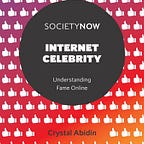Exploitations of Traditional Media
As discussed in my previous posts, there is a cross-section where internet celebrity meets traditional media. Crystal Abidin dedicates a chapter to this in her book ‘Internet Celebrity’ (2018). She discusses different common types of internet celebrity and how they create a presence both online and in mainstream media.
Abidin classifies ‘eyewitness viral stars’ (Abidin, 2018, pg. 38) as interviewees of television news who gain overnight fame from comical phrases or pulling a humorous facial expression. An example discussed in the book is Sweet Brown or, more widely known as the ‘ain’t nobody got time for that’ woman. She was interviewed in 2012 after her apartment building was set on fire and she was evacuated. Sweet Brown, and many other viral meme stars, is an African American woman in a lower socioeconomic standing. The chapter raises the question, is it okay to laugh?
This becomes a grey area, when memes such as this circulate, people begin to use African American Vernacular English, or AAVE (Labov, 1998), like many of these ‘meme stars’ use. Over time this sociolect becomes in danger of being seen as a joke (Sevel-Sørensen, 2019). This creates exoticism amongst middle-classed society through appropriating a marginalised culture (Steel, 2013).
However, becoming a ‘meme’ isn’t always bad. Sweet Brown went on to create merchandise with her catchphrases on and made appearances on talk shows. Although this fame was short-lived, it provided her with financial capital that most other meme stars aren’t successful in doing.
The chapter moves on to discuss ‘childhood commodification’. Abidin uses the case study of the ‘Ellen Show’ who often show viral child internet stars for segments on her show. This is not only true of Ellen…
In 2016, a thirteen-year-old Danielle Bregoli appeared on ‘Dr Phil’ unaware that she would soon become a meme for using the phrase ‘catch me outside, how about that’ when threatening someone. The episode was titled ‘I Want To Give Up My Car-Stealing, Knife-Wielding, Twerking 13-Year-Old Daughter Who Tried To Frame Me For A Crime’. Bregoli then capitalised on this by creating rap music under the name ‘Bhad Bhabie’. Bregoli has recently been accused of appropriating black culture (Dobson & Knezevic, 2018) by ‘tanning’ to the point of racial ambiguity or blackface on Instagram and using AAVE. This case exemplifies the dangers of exploiting an underage person who has a history of violence and crime for entertainment. Bregoli now has a platform she can use to appropriate black culture to millions of impressionable fans.
Where does the responsibility lie to safeguard those who we springboard into fame overnight, without the tools to survive?
Until next time,
PurpleBlogs
References
Abidin, C. (2018). Internet celebrity. Bingley: Emerald Publishing.
Dobson, K., & Knezevic, I. (2018). “Ain’t Nobody Got Time for That!”: Framing and stereotyping in legacy and social media. Canadian journal of communication, 43(3).
Labov, W. (1998). Co-existent systems in African-American vernacular English. African-American English: Structure, History and Use, 110–153.
Sevel-Sørensen, S. (2019). Racial Performances On Social Media-A study of the Sweet Brown memes.
Steele, C. K. (2013). Shaking off the ‘Other’: Appropriation of marginalized cultures and the ‘Harlem Shake’. AoIR Selected Papers of Internet Research.
